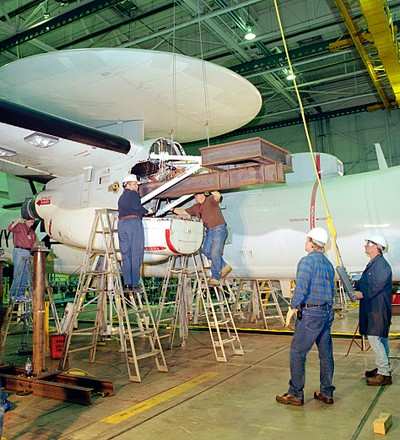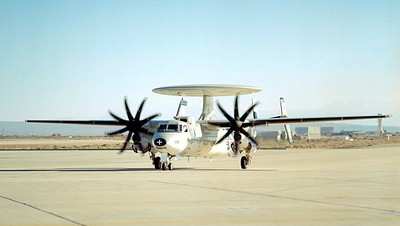Can Gross Weight Be Increased?
A US Navy E-2C Hawkeye, a carrier-based electronics aircraft
that serves as the eyes and ears of carrier battle groups, recently
underwent structural loads tests at NASA Dryden Flight Research
Center's Flight Loads Laboratory to determine if increasing the
aircraft's gross weight will affect its performance.

The Hawkeye, distinctive with its 24-foot diameter rotating
radome and quadruple vertical tails, is part of a fleet of aircraft
that has been operational for more than 40 years. The Navy is
planning upgrades that will add weight to the aircraft. Navy
officials asked NASA Dryden to help formulate loads equations aimed
at determining how the additional weight will affect the aircraft's
flight envelope.
"A loads calibration test is a primary part of the development
of any new aircraft," explained Paul Lundstrom of Spiral
Technology, Dryden's lead test engineer on the project. "It's also
an important step in determining the flight envelope for any new
configuration of an aircraft. So when you get a new configuration
or a new aircraft, you absolutely have to know what the structural
loads are on the airplane when it's in flight. The only good way to
determine that is by doing a test of this nature."
The aircraft arrived at Dryden last fall from its base at the
Naval Air Warfare Center Aircraft Division (NAVAIR) at Naval Air
Station Patuxent River, Md. A Navy crew removed the engines and
propellers, purged fuel tanks and performed other preparations
before NAVAIR and Dryden technicians began installing loads sensors
and other equipment for the structural tests. The work was
completed in mid-March about three weeks ahead of schedule.
The tests in Dryden's Flight Loads Laboratory applied force, or
loads, on the aircraft to develop loads equations, using a
data-recovery system connected to instrumentation on the airplane,
said Lundstrom.

"That data is used to develop what we call loads equations,"
Lundstrom added. "These loads equations can be used (by Navy flight
test engineers) to estimate loads while they're test-flying the
airplane. This allows them to know when they're approaching
in-flight loads that are too high for the structural capacity of
the aircraft. A loads calibration allows us to define the
performance parameters of the aircraft while maintaining a safe
structure."
The E-2C research isn't the biggest project completed in
Dryden's Loads Laboratory, but it is among the largest ever
undertaken and could lead to similar work in the future, he
added.
An unmodified E-2C weighs about 42,000 pounds empty. The Hawkeye
that was tested at Dryden had its weight beefed up with metal
plates to simulate an empty weight of about 45,000 pounds --
mimicking the latest weight configuration of the upgraded E-2D
Advanced Hawkeye, more commonly known as the "Hummer" in the fleet.
Loads were applied to the aircraft's wings and tail.
The E2-C has an 80-foot wingspan, is about 58 feet long and 18
feet tall. Dryden's Loads Laboratory can accommodate the aircraft
with room to spare for equipment and fixtures necessary for
conducting the research.
NAVAIR personnel installed 226 strain gauges, which measure
stress on the aircraft's surface, while NASA technicians mounted 15
string potentiometers, which essentially are electronic measuring
tapes, on the aircraft. Six load cells -- instrumentation that
records how large a force is being applied to an area -- measured
aircraft reactions at fixed points on the ground. An additional 24
load cells were used to monitor and control loads applied to the
wings; another eight were used for the tail.
NAVAIR project engineer Jason Brys said the Navy has been
pleased with the progress that has been made to date.
"We had a few obstacles during the preparation process, but the
three-party team of NASA, NAVAIR, and Northrop Grumman Corp. have
come up with timely solutions," he said.
"The Navy decided to use NASA Dryden because they have unique
facilities and experience that are hard to find elsewhere, and I am
pleased with the support that we have received from Dryden to
date," Brys added.

Lundstrom said the tests on the E-2C illustrate one of two core
competencies of the NASA Dryden Flight Loads Lab.
"We're one of the few locations in the nation that can do this
specific type of test," he said. "Our second very important
capability that we're still in the process of developing and
growing and learning more about, is testing under extreme thermal
conditions. We have a strong tradition here at Dryden for testing
for both of those types of information."
The E-2A Hawkeye first entered service in 1961, was updated in
1969 as the E-2B and the E-2C was introduced in 1973. It performs a
similar role to the Air Force E-3 Airborne Warning and Control
System, also known as AWACS.
 ANN's Daily Aero-Linx (04.15.24)
ANN's Daily Aero-Linx (04.15.24) Classic Aero-TV: 'No Other Options' -- The Israeli Air Force's Danny Shapira
Classic Aero-TV: 'No Other Options' -- The Israeli Air Force's Danny Shapira Aero-News: Quote of the Day (04.15.24)
Aero-News: Quote of the Day (04.15.24) Airborne 04.16.24: RV Update, Affordable Flying Expo, Diamond Lil
Airborne 04.16.24: RV Update, Affordable Flying Expo, Diamond Lil ANN's Daily Aero-Term (04.16.24): Chart Supplement US
ANN's Daily Aero-Term (04.16.24): Chart Supplement US





